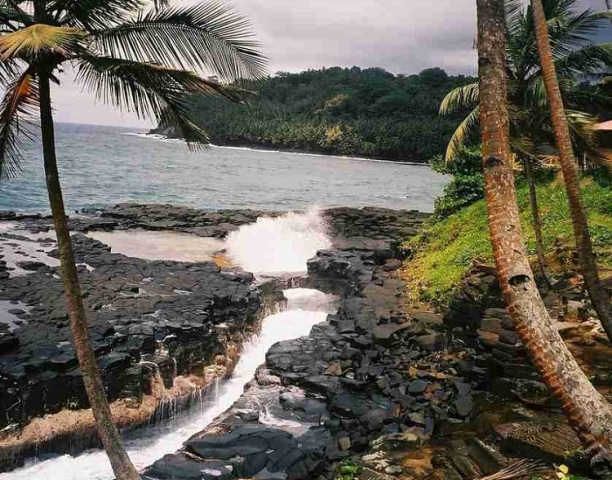Read on to learn few facts about Sao Tome and Principe, the islands that lie on dormant volcanoes and dense forests and rough landscapes.
Facts About Sao Tome & Principe
Sao Tome and Principe, officially known as the Democratic Republic of Sao Tome and Principe, is a Portuguese-speaking island nation situated in the Gulf of Guinea, off the western equatorial coast of Africa. Both the islands are part of an extinct volcanic range. The island of Sao Tome was named after Saint Thomas by the Portuguese explorers who happened to arrive at the island at the saint’s feast day. This island of Sao Tome and Principe was inhabited before the arrival of the Portuguese to the island sometime around 1470. The island was discovered by Joao de Santarem and Pedro Escobar. This poor island country functions under a multiple party system since the 1990s. The president is elected for a period of 5 yrs by direct universal suffrage (voting) and a secret ballot. The elected president can hold the office for two consecutive terms after which a new president should be elected. The economy of the nation since 1800s has been solely dependent on agricultural production. But, the domestic food crop production is not sufficient for the local population; therefore, the country imports some of its food. Other than agriculture, the main economic activities are fishing; a small section is engaged in processing local agricultural products and producing a few basic consumer products. This article will provide you some interesting and fun facts about Sao Tome and Principe, the nation with a mixed culture having both the African and Portuguese influences.

Image: Maria Cartas@flickr
Interesting And Fun Facts About Sao Tome & Principe
- The island nation of São Tomé & Príncipe has a total population of 160,100 as per the 2006 estimate and the total population growth rate as per the 2005 estimate was 3.2%.
- Portuguese is the official language of Sao Tome & Principe nation.
- The country gained independence on the 12th of July 1975 from Portugal.
- The island nation has a long history of domination of the slave trade and slave-worked plantations of various crops.
- Sao Tome and Principe is the second-smallest African country when it comes to population. It is also the smallest country in the world that is not a former British overseas territory, a former U.S trusteeship or one of the European microstates.
- Sao Tome and Principe is the smallest of all Portuguese-speaking countries.
- Sao Tome and Principe has a tropical hot and humid climate with an average yearly temperature of about 27° C. The temperature of this island nation barely rises above 32° C.
- The island of Sao Tome, which has the capital of the same name, consists of 90% of the total country’s surface area. It is a picturesque town consisting of colonial Portuguese architectural tradition and many attractive parks.
- Sao Tome became one of the first African countries to adopt democratic reforms and changes to its constitution.
- Sao Tome and Principe were placed 9th out of the 48 sub-Saharan African countries, during a survey on a comprehensive reflection of the levels of governance in Africa by the Ibrahim Index of African Governance.
- The island nation is home to a large number of birds and plants, including the world’s smallest ibis and the world’s largest sunbird and many other giant species of Begonia.
- Coca is the main crop of the island nation and it represents 95% of the country’s export. Other export crops include copra, palm kernels and coffee.
- There are around 6 banks in the country. The largest and the oldest bank among these 6 banks is ‘Banco Internacional de Sao Tome e Principe’. This bank is the subsidiary of the Portugal government owned Caixa Geral de Depositos.
- Dobra is the currency of the country. The country’s real GDP growth according to the 2006 estimate is 5.5%.
- Netherlands, Portugal, Belgium, Angola, Germany, USA and Brazil are the main trading partners of the nation.
- Malaria is the major and the most dangerous disease prevalent in the nation.
- In 2007, the female expectancy was 67.3 years and the male life expectancy was 63.5 yrs.
- The government of this small nation spends US $ 120 per capita on health services as per the 2006 census.
- Among the major ethnic groups of the nation are Mestico, Angolares, Forros, Servicais and Tongas.
- Coca plantations are major tourist attractions. Apart from this, a tiny island called IIheu Bom Bom, situated off Principe’s northern coast, is another famous tourist hub.
- The recent discovery of oil in the Gulf of Guinea is likely to have a great impact on the economy of the nation.
See also
More from iloveindia.com
- Home Remedies | Ayurveda | Vastu | Yoga | Feng Shui | Tattoos | Fitness | Garden | Nutrition | Parenting | Bikes | Cars | Baby Care | Indian Weddings | Festivals | Party ideas | Horoscope 2015 | Pets | Finance | Figures of Speech | Hotels in India : Delhi | Hyderabad | Chennai | Mumbai | Kolkata | Bangalore | Ahmedabad | Jaipur
- Contact Us Careers Disclaimer Privacy Policy Advertise With Us Lifestyle Sitemap Copyright iloveindia.com. All Rights Reserved.







